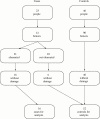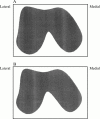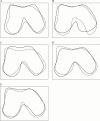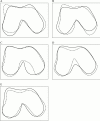The shape of the distal femur: a palaeopathological comparison of eburnated and non-eburnated femora
- PMID: 10343520
- PMCID: PMC1752825
- DOI: 10.1136/ard.58.2.72
The shape of the distal femur: a palaeopathological comparison of eburnated and non-eburnated femora
Abstract
Objectives: To determine the difference in shape of the distal femur, viewed axially in two dimensions, between eburnated and non-eburnated femora.
Methods: A comparison of 52 non-eburnated and 16 eburnated femora drawn from a large archeological skeletal population. Eburnation was taken to indicate late stage osteoarthritis. Shape variability, based on landmarks, was quantified using a principal components analysis after a Procrustes alignment.
Results: A statistically significant difference was found between the two groups. This was with respect to the patellar groove and the shape of the medial condyle. The latter difference is consistent with bone remodelling as a knee stabilising mechanism.
Conclusions: Anatomical shape can be quantified using an uncomplicated statistical technique. It was used to quantify the shape of the distal femur and demonstrate shape differences associated with osteoarthritis of the knee.
Figures







References
Publication types
MeSH terms
LinkOut - more resources
Full Text Sources
Other Literature Sources

